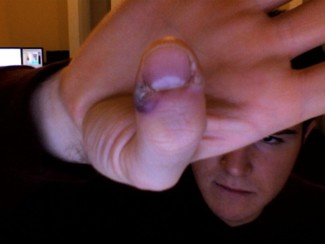All warts are unsightly and irritating. But when a wart gets a bacterial infection, the aggravation shoots to another level.
An infected wart is painful and often discolored. It may discharge pus, a yellowish or greenish liquid produced by infected tissue. A wart infection is potentially dangerous, too. If left untreated, the infection can grow. In extreme cases, the infection enters the bloodstream and spreads to other parts of the body.
With proper attention, however, a simple wart infection is easily treated at home. Let’s take a look at how to properly identify, treat, and prevent wart infections.
How a wart gets infected
Any cut or break in the skin is fertile ground for an infection. The epidermis, or outer layer of skin, protects the body from invading bacteria. Bacteria is allowed entry through even microscopic skin abrasions.
How does this apply to warts? Well, warts are often itchy and irritable. If you scratch or pick at a wart, you are inviting infection. And the flesh of warts on the hands or feet may tear open simply by rubbing against shoes, surfaces, or clothes. A minuscule tear in the skin is all it takes for bacteria to potentially infect a wart.
Warts are also ripe for infection when they are treated with wart removal medication. These products burn off the wart layer by layer, usually with salicylic acid. When the top, protective layer of skin is burned off a wart, the exposed open wound must be kept covered and disinfected. Otherwise, it is likely to become infected. (Read more about preventing wart infection below.)
Symptoms
What does an infected wart look and feel like? It is sensitive and painful. The infected skin becomes crusty and non-flexible. White blood cells attack and attempt to kill the bacteria. This is the result. The seriousness of an infection is often indicated by pain level.
The infected skin discolors — which may range from bloody-red to black. This is normal and usually nothing to worry about. The circulatory system clears out the dead skin cells and the skin repairs itself in a few days.
If skin is black and very painful, however, you should seek medical treatment. Black flesh indicates dead tissue and restricted blood flow. A seemingly simple, localized infection becomes very dangerous if it enters the bloodstream.
It is common for an infected wart to discharge blood and/or pus. Blood seeps through the wound as platelets coagulate and attempt to repair it. Dried blood cakes the outside of the infection, or imbeds under the flesh. In advanced infections, pus, a yellow or green plasma, leaks out.
Treatment
A mild to moderate wart infection can be treated with over-the-counter products. Here’s the procedure:
Clean and sterilize
Thoroughly clean all the infected flesh with antibacterial soap and warm water. Use a cloth to gently brush away crusty, dead skin. This will be painful. Infected skin is very sensitive to touch.
Once you have cleaned the wound as best you can, it’s time to apply an antibacterial agent directly to any open flesh. I recommend iodine for this. Iodine is cheap, found in any drug store, and this is what a hospital would use to kill and prevent infection.
Be warned: Iodine is bright yellow and messy to apply. It stains carpets and upholstery, so apply it over an easy-to-clean surface. Put several drops of iodine directly on any open flesh. This will sting. The pain is a good sign, however. It means the bacteria is being killed.
Use a sterile tissue, gauze pad, or q-tip to smear the iodine into the skin. Be sure to saturate all cracks and crevices of infected skin. Skin soaks up iodine easily. Let the wound absorb it. Iodine is beneficial for the body in many ways, not only as a treatment for infection.
Cover the wart
When almost dry, you should cover the wound with sterile gauze or a band-aid. Always cover a wart infection because this protects it, preventing bacteria from entering. The wart will be tender at this point. Resist the urge to touch or pick at it.
Keep it dry
Do not to get the wart wet while it is healing. If you take a shower, cover the infection with plastic to keep it dry. Water is full of bacteria, and you invite reinfection if you get it wet.
Rinse and repeat
It takes several days for an infection to heal. You need to clean it at least once a day. Twice a day for serious infections. You can stop when skin heals over and the wound is closed and protected.
Prevention
To keep a wart from getting infected, don’t scratch or pick at it. I know warts are itchy and irritable, but scratching rips the skin and makes it vulnerable to infection. If you notice any signs of infection such as pain or bleeding, treat it right away. An ounce of prevention is worth a pound of cure.
If you are using a wart removal product: When burning a wart off with salicylic acid, thuja, etc., keep it covered and disinfected throughout the process. In between treatments, keep the wart sterilized, clean, and covered. Always.
Conclusion
It’s no fun when a wart gets infected. Quick treatment is paramount. A simple infection can quickly become a serious issue if left unattended. But if sterilized and protected, an infected wart can usually be treated at home.
Let me know what you think in the comments below. Please relate your experience and any advice you have. Thanks.
OTC Medicine for Wart Removal
 |  |  |  |
| Wart Remover Pads/Adhesives | Liquid Wart Remover | Wart Freeze Off | Wart Removal Pen |
Photo: “Yummy” by Charles Williams is licensed under CC BY



Leave a Reply